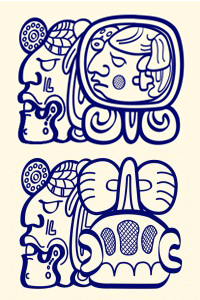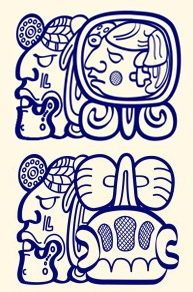
13 Ajaw 13 Mak. Drawing by Jorge Pérez de Lara
All of us at MAM wish you and your families a wonderful holiday, and we send our deepest thanks to all of our supporters for making this an unforgettable year, with the successful Congreso in Huehuetenango. As we move into 2019, we are once again preparing for our yearly holiday fundraiser, while also soon announcing our next call for applications for our upcoming round of mini-grants.
We look forward to another exciting year ahead as our Maya colleagues prepare for the next Congreso, to take place in Quintana Roo, Mexico in 2020, and we are always grateful for all of the support we receive to help the Maya in their efforts to revitalize their ancestral script.
This month, we hear from Daniela Esther Cano Chan, a dynamic teacher who taught an introductory workshop on Maya writing from May 18 to July 15 for twenty five Yucatec Maya students at the Colegio de Bachilleres Plantel in Teabo, Yucatan, just outside of the Pueblo of Maní.
In 1562, Maní was the site of the infamous and tragic auto de fé of Diego de Landa, who burned many Maya codices and religious statues, thereby destroying unknown amounts of Maya history, science, and literature—and almost completely erasing all knowledge of the script. Yet, what once almost vanished has now returned, and it is a profound testimony to the resilience of Maya language, culture, and people that we now see the Maya script return to the very community where this tragedy took place so many years ago. The Maya script lives again.
Yum bo’otik, Na bo’otik,
Michael J. Grofe, President
MAM

Introductory Course in Maya Epigraphy
Daniela Esther Cano Chan
This workshop was designed for young people from the southern area of Yucatan, mostly indigenous people who speak the Yucatec Maya language, from the villages of Maní, Tipikal, Teabo, Mayapan, Cantamayec and Chumayel, in order to share knowledge about the ancient writing of our Mayan grandparents and grandmothers and allow them to have an increasingly strong connection with their roots.

13 Ajaw 13 Mak. Dibujo por Jorge Pérez de Lara
Todos los que trabajamos en MAM les deseamos a usted y a sus familias unas maravillosas vacaciones, y enviamos nuestro más profundo agradecimiento a todos nuestros partidarios por hacer de este un año inolvidable, con el exitoso Congreso en Huehuetenango. A medida que avanzamos en 2019, nos estamos preparando una vez más para nuestra recaudación de fondos anual en diciembre, y también anunciamos pronto nuestra próxima convocatoria de solicitudes para nuestra próxima ronda de mini-becas.
Esperamos otro año emocionante por delante mientras nuestros colegas mayas se preparan para el próximo Congreso, que tendrá lugar en Quintana Roo, México en 2020, y siempre estamos agradecidos por todo el apoyo que recibimos para ayudar a los mayas en sus esfuerzos por revitalizar su escritura ancestral.
Este mes, escuchamos a Daniela Esther Cano Chan, una profesora dinámica que enseñó un taller introductorio sobre escritura maya del 18 de mayo al 15 de julio para veinticinco estudiantes mayas yucatecos en el Colegio de Bachilleres Plantel en Teabo, Yucatán, a las afueras del pueblo de Maní.
En 1562, Maní fue el lugar del infame y trágico auto de fe de Diego de Landa, quien quemó muchos libros mayas y estatuas religiosas, destruyendo así cantidades desconocidas de historia, ciencia y literatura maya—y borrando casi por completo todo el conocimiento de la escritura. Sin embargo, lo que una vez casi desapareció ha regresado ahora, y es un testimonio profundo de la resistencia de la lengua, la cultura y la gente mayas que ahora vemos que la escritura maya regresa a la misma comunidad donde ocurrió esta tragedia hace tantos años. La escritura maya vive de nuevo.
Yum bo’otik, Na bo’otik,
Michael J. Grofe, Presidente
MAM

Curso Inicial de Epigrafía Maya
Daniela Esther Cano Chan
Este taller fue diseñado para jóvenes de la zona sur de Yucatán en su mayoría indígenas que hablan el idioma Maya yucateco, originarios de los pueblos de Maní, Tipikal, Teabo, Mayapan, Cantamayec y Chumayel, con el fin de compartir el conocimiento sobre la escritura antigua de nuestros abuelos y abuelas mayas y que esto les permita tener una conexión cada vez más fuerte con sus raíces. Continue reading

